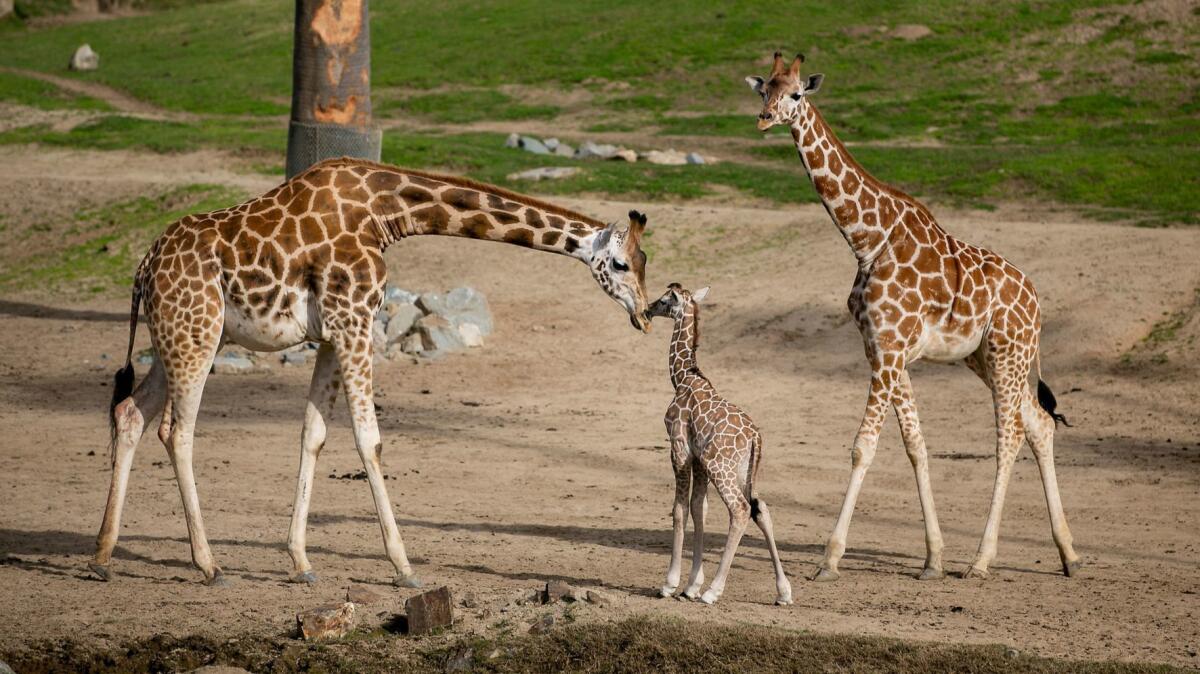From a wet and wobbly start, newborn giraffe joins San Diego Zoo Safari Park

Reporting from San Diego — A little over an hour after entering the world on Sunday, a baby giraffe got to its wobbly legs and finally stayed upright at the San Diego Zoo Safari Park.
With mother Acacia and other members of the herd nuzzling and licking to encourage it, the newborn male at last pulled himself into a shaky, knock-kneed stance that began to firm up.
Finally, the baby took his first sips of mother’s milk.
And so the giraffe population at the Safari Park southeast of Escondido increased by one. It came a month after the death of another male calf, Kumi, apparently gored in the belly by an antelope.
The as-yet-unnamed calf was the 142nd born in the 65-acre East African exhibit, which now has more than a dozen giraffes living in the open. And both baby and mother are doing great, Randy Rieches, the Safari Park’s Director of Collections Husbandry and Science, said Monday afternoon.
“We had keepers that stayed in the field with it for the entire night, mostly to record nursings,” Rieches said. “That way we know the calf is in good shape and continued to have nursing bouts throughout the night.”
Intervention was kept to a minimum, under a program called Opportunities to Thrive that seeks to duplicate as much as feasible natural environments and challenges for the animals.
It’s the same program under which the giraffe and antelope are placed in the same habitat. In nature, these two species communicate with each other, warning of threats. Any giraffe or antelope released into the wild without this understanding may be at a disadvantage.
Likewise, giraffe calves in the wild must get to their feet and move as soon as possible. A giraffe giving birth is vulnerable to predators, and an immobile baby is completely helpless. To survive, the baby must be able to move with the herd.
The birth and learning to stand was in the normal range for giraffes, Rieches said. It takes a bit of time to recover from birth: the calf drops out of its mother to the ground, about a six-foot fall. And then it must learn to extend and stabilize its legs.
You can see the event unfold on Safari Park video at https://bit.ly/giraffeborn. Skip to 22 minutes into the video to see the final emergence of the baby, legs first.
Just after 23 minutes, the half-extruded calf suddenly drops to the ground.
The newborn giraffe lies in a sodden heap, heaving spasmodically with its first gulps of air. It gathers its legs, half-stands, and collapses back. Then it raises its head, struggles to its feet several times, falling back down into a ditch.
While this is going on, other members of the herd gather by. At one point, an inadvertent nudge from an inquisitive bull giraffe sends the baby back to the ground.
Then Safari Park trucks arrived, sheltering the calf and mom from the others. These trucks happened to have food, which some of the males nibbled on.
This is the only intervention the Safari Park performed, to give mother and calf time to work things out on their own. Eventually, the calf stands and starts to nurse.
If necessary, zoo staff would have stepped in to help, Rieches said. Safari Park veterinarians have performed C-sections when normal delivery wasn’t feasible, he said. But that’s done rarely, in part because it endangers the bonding between mother and calf.
“The bond is broken, and sometimes it’s never picked back up,” he said. “We’ve had to hand-raise some giraffes before. But for the most part, we’ve done very well with them being raised in the habitat.”
Even after 142 births, the arrival of any giraffe is cause for joy, Rieches said, because the animals face survival threats in the wild.
The father isn’t yet known. Mother Acacia, 6, is a reticulated giraffe, a subspecies listed as endangered by the International Union for the Conservation of Nature, or IUCN. According to a census released last November, there are 15,784 reticulated giraffes in the wild. Also known as the Somali giraffe, the species is native to the Horn of Africa.
Visitors can see the newborn at the Safari Park’s East Africa exhibit in African Outpost by taking the Africa Tram. Or travel by computer to the Giraffe Cam at www.sdzsafaripark.org/giraffe-cam.
Fikes writes for the San Diego Union-Tribune.
More to Read
Sign up for Essential California
The most important California stories and recommendations in your inbox every morning.
You may occasionally receive promotional content from the Los Angeles Times.











